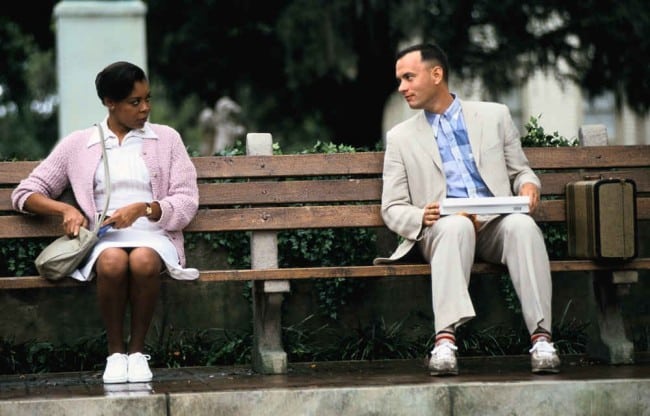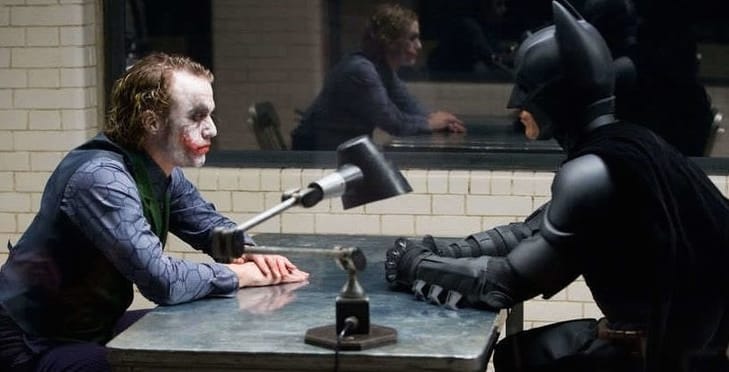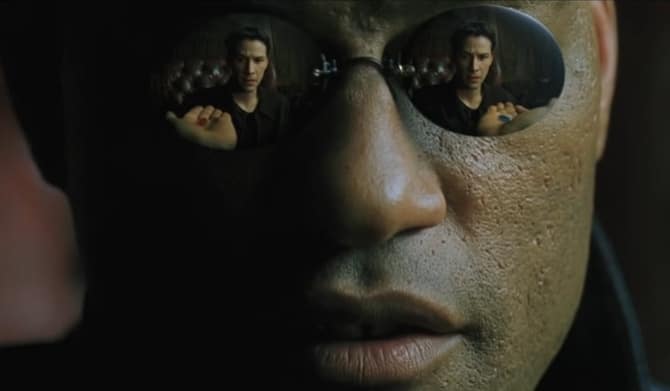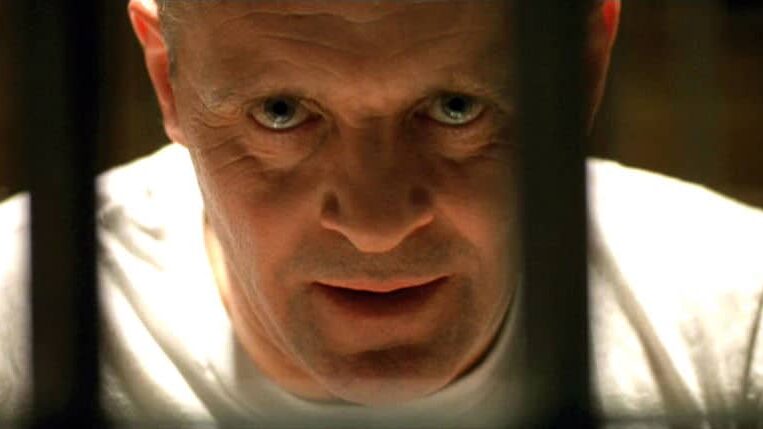What is a Literary Device?

But literary devices are about much more than making your work ‘memeable’. Writers also use literary devices to give their work a level of opacity, or a scope for interpretation. Broadly speaking, literary devices establish connections.
The ambiguity of these connections also allows viewers to engage with a screenplay in their own way. Arguably, no one human being sees the world exactly the same; we all have our own specific take on it. Thus, for large audiences to connect individually with your work you must provide them with the space to find their own meaning.
Literary devices are therefore essential for allowing your work to have an emotive impact on as many people as possible. They’re a common language.
Categorizing Literary Devices
The term ‘literary device’ can be broken down into two categories: ‘literary elements’ and ‘literary techniques’.
- Literary elements are the fundamental components that make up your story. These include plot, themes, or characters.
- Literary techniques are the specific methods writers use to make their writing more interesting, engaging and effective.
To help clarify this in your mind, think of a building.
- Literary elements are like the building’s foundations and structure. Just as a building needs these to stand up, a screenplay needs literary elements to give it coherence.
- Literary techniques are like a building’s paint and decor in that they enhance a screenplay’s aesthetic qualities and overall impact.
Literary elements are literary devices that extend throughout the entire story. Whilst literary techniques are the literary devices that apply to smaller-scale elements of the story such as dialogue or individual scenes.
A List of Literary Elements
1. Plot: the plot is the sequence of events and actions that make up a story’s narrative. It is the structure that holds a screenplay together. The plot includes the introduction, rising action, climax, falling action and resolution.
2. Rising action: rising action refers to the sequence of events building up to the climax. It establishes the characters and their motivations as well as setting up a story’s conflict. Crucially, in this part of the narrative, the protagonist faces challenges that test their ability and forces them to make important decisions.
3. Climax: the climax is the moment of greatest tension or action. It is the turning point in which the protagonist faces their greatest challenge yet.
4. Falling action: falling action denotes the sequence of events that proceed after the climax. It is here that the conflict and tensions of your narrative begin to subside.
5. Resolution: resolution refers to the end of a screenplay. It provides closure, answering any lingering questions and settling all remaining conflicts. Arguably, it is the most important part of any screenplay. This is because it provides an overall sense of meaning and significance to the events the audience has just witnessed.
6. Protagonist: the protagonist is the main character of your story. Typically, they are the character that drives the plot forward and with whom the audience identifies most closely. In Batman: The Dark Knight, for example, the protagonist is Bruce Wayne.
7. Antagonist: the antagonist is a character, group of characters or force (like nature or society) that opposes the protagonist. Crucially, the antagonist creates obstacles for the protagonist to overcome. In Batman: The Dark Knight, the antagonist is The Joker.

8. Character Arc: a character arc refers to the evolution of a character over the course of the story. Their outlook or beliefs may change, or perhaps their relationship with others. Whatever character arc you choose, this growth is essential to providing your story with a deeper purpose and the audience with a sense of hope. In One Flew Over the Cuckoo’s Nest, for instance, the protagonist’s character arc is one of transformation. He begins as a selfish, carefree criminal but becomes a selfless leader who sacrifices himself for the betterment of his fellow patients.
9. Point of View: point of view is the perspective from which a story is told. There are three main points of view, each of which determines how the viewer interacts with and understands a narrative.
- 10. First-person perspective – focuses on one character. The audience experiences the story through their mind. It can be particularly effective in expressing a character’s internal struggles. This is because the audience is intimately exposed to their thoughts and feelings. The Handmaid’s Tale is an example of the use of first-person perspective.
- 11. Second-person perspective – is a type of writing that speaks directly to the viewer. You might use it to strengthen the emotional bond between your protagonist and the audience. It can, however, be hard to sustain. Second-person perspective is most effective when combined with another point of view, as in Fleabag.

- 12. Third-person perspective – is when the story is told by an external narrator. The Godfather, for example, uses a third-person perspective in that the audience is never made aware of any character’s inner thoughts. Instead, the narrator provides information about the character’s actions which allows the audience to develop a picture of the Corleone family as a whole.
13. Theme: a theme is the central idea or underlying message explored throughout a story. It provides an overarching frame that ties each scene together, imbuing your work with depth and meaning. In Moonlight, for example, the central theme is the black male identity and its interaction with sexuality.
14. Sub-theme: sub-theme is a more specific idea that can be used to further explore a story’s core theme. You might think of sub-themes as the individual pieces of a jigsaw puzzle with the overall picture they create being the central theme. Moonlight’s sub-themes include family, poverty, drug addiction, abuse, the desire to belong, and the power of love.
15. Motif: a motif is a recurring element or idea within a story. They often contribute to the overall theme by giving it a more concrete and specific representation. You might express a motif through physical items, symbols, sound design or lines of dialogue. In American Beauty, for instance, Sam Mendes uses the motif of a plastic bag floating in the wind. From one perspective, this reflects the emptiness and superficiality of the American Dream that all the characters are chasing.
16. Extended Metaphor: an extended metaphor uses the literary device of a metaphor but expands it. It is sustained or developed throughout a script. In The Truman Show, an insurance salesman is oblivious to the fact that his entire life is a TV show and his family members are mere actors. This is an extended metaphor for the ways in which modern media create false realities and manipulates people’s perceptions and beliefs.

17. Conflict: conflict is an essential element of every screenplay. It provides tension and drives the narrative forward. It can be characterized as a struggle between opposing forces. There are four key types of conflict:
- 18. ‘Man vs. Man’ – is where a protagonist and antagonist clash due to opposing beliefs or goals. This type of conflict can be seen, for example, in Star Wars where Luke Skywalker battles Darth Vader.
- 19. ‘Man vs. Nature’ – involves a character that is pitted against the forces of nature. For example, in I am Legend the protagonist struggles to survive in a post-apocalyptic New York whilst trying to find a cure for the disease that ravaged his homeland.
- 20. ‘Man vs. Himself’ – entails a character who struggles with their own desires, goals and beliefs. A classic example of this is Hamlet, who wrestles with his internal struggle and place within the story.
- 21. ‘Man vs. Society’ – involves a character’s struggle against oppressive societal forces. In V for Vendetta, for example, an anarchist revolutionary fights against the totalitarian regime that has seized control of the UK.
22. Suspense: suspense is a literary device that creates tension or uncertainty for the viewer. It is used to keep audiences invested and engaged throughout. There are many ways you might create suspense, with foreshadowing or the use of sound being just two examples. In Inception, for example, Nolan creates suspense by keeping the audience guessing as to what is real and what is a dream.
23. Anti-climax: anti-climax refers to an abrupt let-down or tonal shift at the end of a series of highly charged moments. You might use it to bring your story to an unexpected yet satisfying conclusion or leave the audience wanting more (perhaps a sequel or a new story in the same universe). Alternatively, you might use it to inject a sense of humor into your narrative.
24. Setting: setting refers to the location, time period, and environment in which a story takes place. It helps the audience to understand the actions and emotional lives of the characters in your story.
25. Mood: the mood of a screenplay is what affects the audience emotionally and psychologically. It denotes a story’s overall feeling. Mood is omnipresent throughout. It is created by your use of language, imagery, setting, sound, and lighting. Examples may include sentimentality, romance and excitement.
26. Genre: genre refers to the way in which screenplays are categorized. These include action, comedy, horror, romance, science-fiction or fantasy. Films within these categories share similar narrative elements, themes, or conventions.
27. Allegory: an allegory is a story that can be interpreted to reveal a hidden meaning. Writers often use them to explain philosophical concepts or to make political or social comments. The Matrix, for example, is one of the most iconic examples of an allegory. In this sci-fi classic, Neo discovers that the world as he knows it is in fact a simulated reality. The choice he faces between taking the red pill or the blue pill is an allegory for the idea of free will and choosing between a life of freedom or control, knowledge or ignorance. This can also be used in a more specific way as a literary device, within a character’s dialogue, for example.

28. Parody: parody is a type of humor that involves copying the style of someone or something in a way that makes fun of it or exaggerates its characteristics. For example, Spinal Tap is a parody of rock-and-roll bands and the wild lifestyles they lead as well as the type of documentaries that chronicle their lives on tour.
29. Caricature: a caricature is the presentation of an object, idea or person that exaggerates certain features for comedic or critical effect. The TV show South Park uses caricature to satirize various political and social issues as well as many popular cultural figures.
30. Archetype: archetypes are templates you might use when creating a compelling and relatable character. They include, for instance: ‘the hero’, ‘the villain‘, ‘the love interest’, or ‘the comic relief’. These archetypes embody certain personality traits and motivations that are instantly recognizable to audiences. This helps them to connect with a story more easily.
31. Personification: As exemplified by Finding Nemo or Toy Story, personification is when non-humans are given human qualities, characteristics or emotions.
32. Flashback: a flashback is a literary device that recounts events that occurred in the past in relation to the main story. You might use it to provide background information or reveal a character’s trauma. The film Memento uses flashbacks to reveal the events leading up to the protagonist’s amnesia.
33. Flash-forward: a flash-forward, perhaps most commonly associated with Ebeneezer Scrooge (from A Christmas Carol), is a literary device in which a story jumps forward in time to show a future event or scene.
34. Anachronism: the term ‘anachronism’ is a Greek word meaning ‘backward time’. It is a literary device in which a writer places someone or something from a specific time period in the wrong historical context. You might use anachronisms in your own writing to create: a sense of nostalgia, to highlight a contrast between past and present, or to bring a certain level of familiarity to your story. Jesus Christ Superstar, for instance, contains many anachronistic elements. For example, Judas is depicted as a young revolutionary and Mary Magdalene as a feminist. This is intended to highlight the relevance of Jesus’s message in today’s world. You should, however, be careful when deploying anachronisms; they can equally be received as a sign of sloppy writing.
A List of Literary Techniques.
35. Metaphor: a metaphor is a literary device in which a word or phrase is used to describe an object or action even though it is not literally applicable. Metaphors can make complex ideas and emotions more tangible and thus relatable to an audience. For example, the metaphor – ‘all the world’s a stage’ – expresses the idea that life is a performance or a series of acts and that each person plays a role in that performance.
36. Symbolism: symbolism is a literary device in which a writer uses one thing to represent something else (often something abstract or complex). You might use it to create connections between characters and themes. Or, to insinuate certain ideas and emotions.
37. Imagery: imagery in screenwriting refers to the use of descriptive language or visual elements to represent an idea, character, event, or mood. Often imagery contributes to a story’s motif.
38. Gesture: a gesture refers to a physical action or movement made by a character that conveys their emotions, thoughts or intentions.
39. Alliteration: alliteration is a literary device in which a series of words or syllables in a phrase or sentence begin with the same sound. Alliteration is often used in poetry or prose. But, you might incorporate it into your own screenwriting to create a rhythmic and memorable effect within lines of dialogue.
40. Cacophony: the term cacophony refers to the use of sound and dialogue to create a sense of chaos or disorientation. This can be achieved through the use of overlapping dialogue or competing sound effects, or both, as was the case in the beach landing scene in Spielberg’s Saving Private Ryan.
41. Onomatopoeia: an onomatopoeia refers to the formation of a word whose sound imitates the thing signified, like in The Silence of the Lambs, when Hannibal Lecter says – “Pity about poor Catherine though. Tick-tock, tick-tock”.

42. Pun: a pun is a form of wordplay that exploits multiple meanings of a term.
43. Allusion: an allusion is an expression intended to call something to mind without mentioning it directly.
44. Adynaton: adynaton is a figure of speech in which the speaker describes a highly unlikely situation in an exaggerated way. You might use it to express a character’s frustration, disappointment or disbelief whilst, at the same time, evoking a sense of humor, irony or sarcasm.
45. Oxymoron: like Back to the Future‘s title, an oxymoron is a combination of words whose meanings seem to be mutually contradictory. Writers often use them to draw attention to something contradictory or idiosyncratic.
46. Antiphrasis: antiphrasis is a figure of speech in which a word or phrase is used in the opposite sense to its usual or intended meaning. For example, something horrible may be described as ‘pretty’. Whilst someone small might be described as a ‘giant’.
47. Antithesis: an antithesis is a figure of speech in which two opposite ideas are put together in a sentence. The contrasting effect achieved highlights the point made. For example, the phrase ‘Keep your friends close, but your enemies closer’.
48. Epigram: an epigram is a short and memorable statement that expresses a truth or a witty observation about life. For example, ‘there is only one thing in the world worse than being talked about, and that is not being talked about’.
49. Monologue: a monologue is a long speech in which a character speaks their thoughts or feelings aloud either to themselves or others. Monologues can provide invaluable insight into a character’s head space. This enables an audience to understand more clearly the motivations behind a character’s actions.
50. Hypophora: hypophora is when a character raises a question and then immediately answers it themselves. It is often used to emphasize a point. For example, in The West Wing, Bartlet asks – “what’s next?” – and then immediately answers – “Education. It’s the future”.
51. Anaphora: anaphora is a literary device used to highlight a point by repeating a word or phrase at the beginning of consecutive sentences or clauses.
52. Enumeration: enumeration is a list which counts out or specifies items or thoughts one by one. It is a technique that writers use to create a sense of emphasis or to organize information in a clear and structured way. In this monologue from The Wolf of Wall Street, the character Jordan Belfort explains the strategy of ‘flipping’ by enumerating the steps involved:
“So what do we do? We call every broker in the office, and I mean every broker, we tell them to buy as much as they can, we flood the market with orders, we create panic. And then, when the dust settles, we cash in. And that, my friends, is called flipping, and it’s the backbone of our success. First, we create scarcity. Then we create demand. And finally, we drop the supply. And that, my friends, is how you make money.”
53. Exhortation: entails a character delivering a speech or monologue that aims to inspire or motivate the other characters or the audience. There is perhaps no better example of exhortation than Winston Churchill’s speech in Darkest Hour.
54. Antanaclasis: antanaclasis is a figure of speech in which a word is repeated in the same sentence but with a different meaning the second time. An example comes in Othello: “Put out the light, then put out the light…”. You might use this device to inject a layer of humor into your dialogue or to emphasize a point.
55. Echolalia: refers to the repetition of a phrase or line of dialogue from a previous scene. You might use it in your script to create a sense of continuity or to emphasize a particular motif. For example, a character may repeat a phrase they heard earlier in the story, thus drawing attention to the significance of that phrase and its connection to the plot.
56. Cliche: a cliche is a phrase or expression that has been overused to the point of losing its original impact. Whilst cliches are generally something you want to avoid in your writing, they can be used ironically or parodically.
For example, in Breaking Bad, Gus Fring uses the cliched phrase – “I have business to attend to” – right before killing one of his rivals. The use of this cliche is, therefore, ironic in that it is often used in very mundane situations but here is used to signal something dramatic and coded.
57. Euphemism: a literary device that is a mild or polite word or expression used in place of one considered to be too harsh or blunt when referring to something unpleasant or embarrassing. For example, saying ‘he passed away’ instead of ‘he died’.
58. Slang: slang refers to the informal words or phrases that are more common in speech than writing. These words or phrases often have a specific meaning within a particular context or group. You might use slang when writing dialogue to create a sense of realism and authenticity.
59. Jargon: the term jargon refers to the use of words by a specific profession or group that are difficult for others to understand. In medicine, this might be terms like ‘malign’ or ‘malignant’. Jargon has much the same effect as the use of slang but is typically deployed in a professional context.
60. Gibberish: gibberish is a literary device that refers to language that is nonsensical or meaningless.
61. Chiasmus: chiasmus is when the words of a sentence are repeated in reverse order. This could be used for dramatic or comedic impact. For example, in Mean Girls, a character says: “Laura, I don’t hate you because you’re fat. You’re fat because I hate you”.
62. Ellipsis: an ellipsis is a literary device in which words are omitted from a sentence with the intention of creating a dramatic effect. This can indicate, for instance, an interruption of thought or an emotion that gets in the way of speech.
63. Caesura: in a screenplay, a caesura refers to a pause or interruption in the action or dialogue, often indicated by a cut or fade to black. You might use it in your own work to create suspense or to separate different segments of the narrative.
64. Anacoluthon: anacoluthon is a figure of speech in which a sentence is broken off in the middle and re-started in a different direction. You might use it to express a character’s abrupt change of thought or emotion.
65. Acronym: an acronym is an abbreviation that is formed from the first letters of a group of words. These letters are then combined to create a new word.
In the Marvel universe, ‘S.H.I.E.L.D’, a secret government organisation, stands for Strategic Homeland Intervention Enforcement and Logistics Division.
66. Anagram: an anagram is a type of wordplay in which the letters of a word or phrase are rearranged to form a new word or phrase. For example, ‘neat’ is an anagram of ‘a net’. You may use this in screenwriting to hide, layer or signal information.
67. Foreshadowing: a literary device in which a writer gives an advance hint of what is to come later in the story. It typically enhances the audience’s experience of the intended themes and messages of the story.
68: Situational Irony: when expectations of a situation contrast with what actually happens. This might occur, for example, when an event happens in a setting that you’d least expect it to happen in. Or it might occur to a character who behaves in exactly the opposite way of what they are preaching.
69: Synecdoche: when a figure of speech is used to encapsulate something whole. For example, the U.S Olympic team may be represented by the use of ‘America’ or ‘wheels’ may be used to refer to the whole car.
70: Vignette: a brief but evocative description, account or episode. In screenwriting, it may be used to detour from the main narrative in order to provide insight and context to a specific character, theme, concept or setting.
– What did you think of this article? Share It, Like It, give it a rating, and let us know your thoughts in the comments box further down…
– Struggling with a script or book? Story analysis is what we do, all day, every day… check out our range of script coverage services for writers & filmmakers.
This article was written by Theo Collins and edited by IS Staff.
Get *ALL* our FREE Resources
Tackle the trickiest areas of screenwriting with our exclusive eBooks. Get all our FREE resources when you join 60,000 filmmakers on our mailing list!


Thank you for this article! This list of literary devices explains a lot about structure- something I was struggling with. Perfect!
Most welcome Linda!
Thanks for the list of Literary Devices!